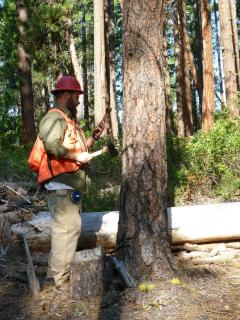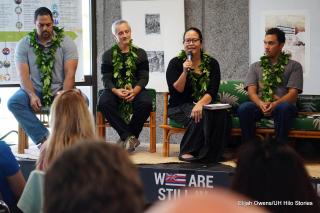Pacific Southwest Research Station scientists shed light on Fifth National Climate Assessment
CALIFORNIA—Climate change affects nearly every facet of our lives and the other living things with which we share the planet. Pacific Southwest Research Station scientists Chris Fettig, Christian Giardina and Rich MacKenzie joined with other scientists to contribute their findings on how climate change affects people and nature throughout the U.S. for the Fifth National Climate Assessment.
Although their geographic locations and research vary, Fettig, Giardina and MacKenzie share a deep passion for their work on climate change.
Forest threats
Sustaining forests that provide clean air, healthy watersheds and more drives Fettig’s research.
“A lot of people aren’t aware that forests represent a third of our land base in the U.S.,” he stated.
California forests face relentless threats from the effects of climate change—severe wildfires, bark beetle outbreaks, warming temperatures and prolonged droughts.
“Climate change impacts every part of the world, but here in the West, we’ve seen it first and worst, especially when it comes to wildfires and bark beetle outbreaks,” Fettig stated.
Battle-weary trees, affected by wildfire and drought in western forests, struggle to fend off native bark beetles. Compromising the already weakened trees, warming temperatures accelerate the lifecycles of some beetles, which strip forests of their foundation—the mother trees—the oldest and largest.
Fettig and others investigate how bark beetles, drought and wildfires influence tree mortality. They set up 180 research plots in the Sierra Nevada to measure the survival rate of ponderosa pines over the course of many years. When megadroughts struck the Southwest from 2014 to 2017, they eviscerated the ponderosa pines. Ninety percent of the trees in the plots died—most infested with bark beetles.
“Less than one quarter of an inch, bark beetles bore into trees, feed on their living tissue and inject them with blue stain fungi, which hasten their death,” Fettig explained.
The ponderosa pine study results were sobering, but even more surprising to Fettig is the precipitous decline of whitebark pine in other western areas. “Looking back on my career, I wouldn’t have believed that in 2023 whitebark pine, a common tree across high-elevation forests, would become federally threatened. But climate change, mountain pine beetle and white pine blister rust have pummeled this tree species.”
Despite the grim news, Fettig and other researchers have made strides in addressing forest threats, including using a pheromone called verbenone to repel certain bark beetles from trees.
Hawaiian ecosystems
An ocean away from Fettig’s work in the Golden State, Christian Giardina researches how climate change affects tropical forests and vital watersheds in Hawai’i.
How drought impacts fire regimes, forest hydrology and watershed health is a key topic that informs Giardina’s work.
Threats to Hawaiian ecosystems mirror those of California—warming temperatures, decreased precipitation, sea level rise and severe wildfires. But in Hawai’i, climate change presents unique challenges in a tropical environment that sustains a close-knit community.
“Twenty-five percent of the state of Hawai’i is prone to wildfires,” Giardina said.
In August 2023, wildfires in Maui devastated local communities, leading to loss of lives, homes, infrastructure and ecosystems.
As warming temperatures increase the lifecycle of bark beetles in California, they are also extending that of mosquitos in Hawai’i, which infect birds with a deadly avian malaria.
“Mosquitos and the malaria parasite can survive at higher elevations as temperatures warm. Sadly, avian malaria is decimating Hawaiian honeycreepers and other native birds,” Giardina explained.
Giardina added that an under-appreciated aspect of climate change is how non-native, often invasive insects, and fungal diseases make their way to Hawaiʻi. Warming temperatures can magnify the impact of these invaders, while droughts can stress plants, making them more vulnerable to insects and disease.
One such disease is Rapid ʻŌhiʻa Death, caused by invasive fungal pathogens that infect native ōhi‘a trees, a keystone species in Hawai’i. It's a major concern, but there’s hope. Giardina and other researchers are making inroads on research that could lead to ROD-resistant ōhi‘a trees.
“I’m not only excited about research breakthroughs for addressing ROD, but also finding community-based solutions to mitigate climate change. There’s a grassroots push for Hawai’i to achieve carbon neutrality,” Giardina stated.
Blue carbon
Like Giardina, Rich MacKenzie is passionate about addressing climate change and promoting the power of blue carbon. Blue carbon is the ability of wetlands, coastal areas and mangroves to absorb carbon dioxide at a significantly higher rate than surrounding forests.
MacKenzie and other researchers are evaluating how climate changes affects ecosystems.
Using stream monitoring plots, he and others observe how changes in rainfall impact stream function in Hawai’i. Currently stationed in Palau, MacKenzie has also set up forest monitoring plots to track how mangroves are responding to sea-level rise in the U.S.-Affiliated Pacific Islands.
“Decreased streamflow from less rainfall causes the demise of native shrimp and other invertebrates,” MacKenzie said. He’s also concerned about impacts of sea level rise on mangroves.
“Mangroves have dealt with sea level rise in the past, but it’s unclear how they will respond to increased rates in the future. Our studies are helping identify mangrove forests that are resilient to sea level rise, which agencies should prioritize for conservation,” he added.
Mangroves and invertebrates are part of an interconnected food web. Invertebrates improve water quality, acting as brooms that sweep streams by feeding on plankton and algae. Mangroves provide sheltered areas for these invertebrates, which, in turn, provide food for ducks, egrets, fish and other animals, while helping sustain local traditions.
In Palau, fisherwomen invited MacKenzie to one such cultural tradition, where they wade out into a stream and kick up clams with their bare feet.
“I was honored the women invited me to join them. It was really special,” MacKenzie stated.
Despite their integral role in cultural traditions and absorbing carbon, feelings about mangroves are mixed. Some view them as harmful to the environment, while others see them as obstacles to development. This motivates MacKenzie, even more, to advocate for their conservation.
Continuing their climate change research and sharing their findings, MacKenzie, Giardina and Fettig model primatologist Jane Goodall’s mantra that “…real hope…requires action and engagement.”



